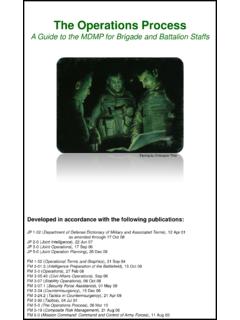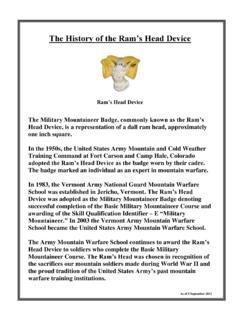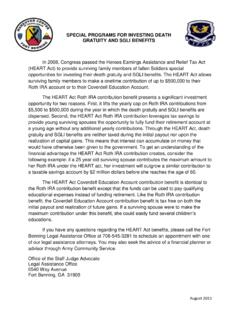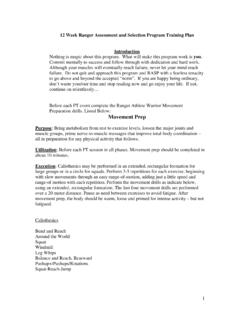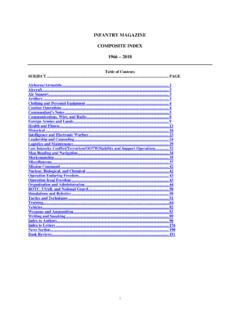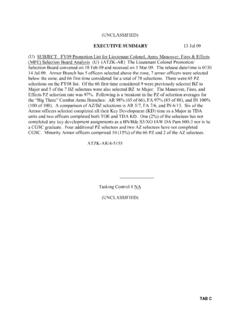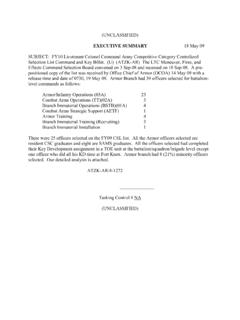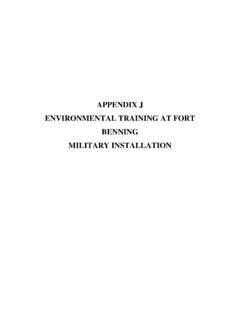Transcription of ADULT TEACHING AND LEARNING USER S GUIDE
1 ADULT TEACHING AND LEARNING USER S GUIDE The Army University Center for TEACHING and LEARNING Excellence Faculty and Staff Development Division Fort Leavenworth, Kansas 66027-1352 i TABLE OF CONTENTS Table of Contents .. i List of Figures .. iii Preface .. v Abbreviations .. vii Glossary .. ix Chapter 1 Foundations of ADULT LEARNING Theory .. 1 Chapter 2 The ARMY Experiential LEARNING Model (ELM) .. 7 The Experiential LEARNING Model: A Five-Step Process .. 10 Concrete Experience .. 10 Publish and Process .. 10 Generalize New Information.
2 11 Develop .. 11 Apply .. 11 Chapter 3 The Power of Concrete Experience .. 17 Overview .. 17 Theoretical Foundation .. 17 Examples of Concrete Experiences .. 17 Video Clip .. 18 Picture .. 18 Practical Exercise .. 18 Story .. 18 Role-play scenario .. 19 Chapter 4 Generalize New Information .. 21 Introduction .. 21 Discussion Method .. 21 Case Study Method .. 23 Practical Exercise Method .. 24 Role-Play 25 Gaming Method .. 26 ii Brainstorming Method .. 26 Guest Speaker Method .. 27 Lecture Method .. 28 Study Assignment Method.
3 30 Chapter 5 Bloom s Taxonomy .. 33 LEARNING Domains .. 33 Relationship between LEARNING Domains and Levels of LEARNING .. 33 Relationship Between LEARNING Objective Action Verb and Level of LEARNING .. 33 Cognitive Domain .. 33 Affective Domain .. 36 The Relationship of the Affective Domain Structure and Common Affective Terms .. 37 References .. 39 iii LIST OF FIGURES Figure 1. Relationship of Training and Education to Bloom s Taxonomy .. 4 Figure 2. Effects of Repetitive Training .. 4 Figure 3. Consistency of Training and Education with US Army Philosophy and Values.
4 5 Figure 4. Comparison of Experiential LEARNING Models .. 8 Figure 5. The Army Experiential LEARNING Model Job Aid (JA-02) .. 9 v PREFACE This User s GUIDE is intended to serve as a tool for new and experienced faculty members as they reflect on their practice as instructors. Additionally, it provides detailed descriptions of each step of the ELM, and offers suggestions regarding how these can be implemented effectively in a US Army classroom. Based on comments by participants in faculty development courses, it is clear that some confusion about the ELM exists among both new and experienced faculty.
5 New instructors have difficulty realizing the flexibility inherent in the model; more experienced instructors tend to challenge the model, or at least components within the model, as rigid, overly simplistic, and not reflective of the dynamics within a modern, diverse classroom. Since the early days, the use of the ELM has grown in its understanding about how the model can be used most effectively. What is presented here, we believe, is a more comprehensive and sophisticated interpretation of the ELM than was initially taught. As currently used, the ELM provides a sound basis for lesson design and development and serves as a common framework for lesson plan construction.
6 While the model provides a structured method for writing lessons, it is a versatile TEACHING approach that accommodates a wide range of effective TEACHING techniques. The ELM provides a flexible framework for classroom management that is responsive to students varied LEARNING paths within a diverse classroom setting. It is hoped that a periodic review of this User s GUIDE will help prevent the instructor from falling into bad habits and will trigger new ideas about how to conduct your own classes more effectively. vii ABBREVIATIONS AAR After Action Review AIS Accountable Instructional System ASAT Army Systems Approach to Training CE Concrete Experience (a step of the ELM) CGSC Army Command and General Staff College DAPS Defense Automation Printing Service DC Deputy Commandant ELM Experiential LEARNING Model ELO Enabling LEARNING Objective GNI Generalize New Information (a step of the ELM)
7 ILE Intermediate Level Education IMS International Military Student IPR In-progress Review JPME Joint Professional Military Education P&P Publish and Process (a step of the ELM) PJE Program for Joint Education QAO Quality Assurance Office SME Subject Matter Expert TLO Terminal LEARNING Objective ix GLOSSARY Action Statement. An element of the LEARNING objective. The LEARNING objective action statement specifies what a student is to be able to do as a result of the educational experience. Advance Sheet. Derived from the lesson plan.
8 The advance sheet provides the student with key information about the lesson scope, LEARNING objectives, and study requirements. For CGSC courses, there are two types of advance sheets--block advance sheets and lesson advance sheets. Affective Domain. One of three LEARNING domains defined in Bloom s Taxonomy. The affective domain deals with the emotional, or feeling, aspect of LEARNING and offers the means for the student to internalize the new material that the teacher is presenting. Without this internalization the new material does not become part of the student.
9 The affective domain consists of five levels: receiving, responding, valuing, organization, and characterization of a value or value complex. The progression through these five levels is from simply being aware through an organized internalization of an attitude or value which becomes the defining characteristics of that person. Analysis Phase. First phase of the Accountable Instructional System (AIS). The analysis phase is the critical link between identifying the educational requirements and developing the instruction. The phase begins with the LEARNING objective action statement or given topic.
10 In this phase, the lesson author must determine what to teach, how much to teach, the students backgrounds, and the available resources. Apply. Fifth and last step of the CGSC Experiential LEARNING Model; the check on LEARNING . The apply is similar to the Assessment, in that it is linked to ELO standards; however, the apply should not be delayed. The apply serves as a means for the verification of students achievement of the ELO standards before they leave the classroom. Instructors have significant latitude on how to accomplish this and may use such techniques as muddiest point, one-sentence summary, and other approaches.
